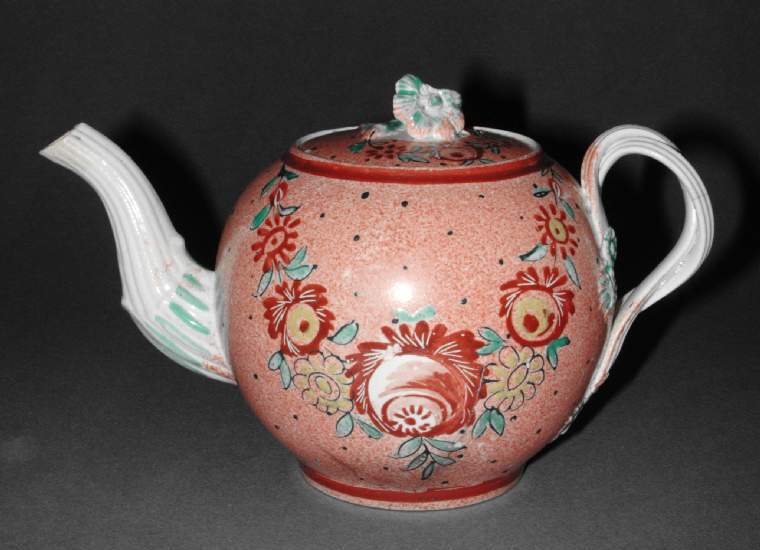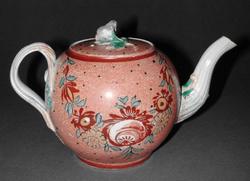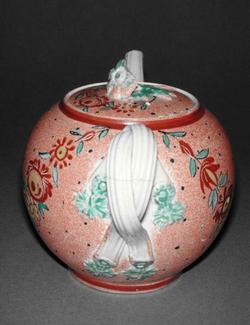Current Location: In storage
Maker(s)
Factory:
Unidentified Yorkshire factory
(Possibly)
Factory:
Unidentified Staffordshire Pottery
(Possibly)
Entities
Categories
Description
Lead-glazed creamware with overglaze enamel decoration.
Cream-coloured earthenware with a lead glaze and overglaze painting and sponging in enamels. The thrown teapot has a globular body with a ribbed spout, enfolded at the base by acanthus-leaves, and a handle in the form of two interlaced ribbons with flower and leaf shaped terminals. The lid has a flower knob with moulded buds and leaves at the base of the flower stem. The knob, handle terminals and acanthus leaves of the spout are painted in green enamel. The teapot body is sponged all over with deep salmon-pink, on top of which is painted a pattern of black dots and, on each side of the teapot, a large festoon of red and yellow flowers with green leaves and black outlines.
Notes
History note: Provenance unidentified before Mr. Jolley, Cambridge, who sold for £1.5.0 in 1904 to Dr J.W.L. Glaisher, FRS, Trinity College, Cambridge
Legal notes
Dr J.W.L. Glaisher Bequest
Measurements and weight
Width: 18.4 cm
Acquisition and important dates
Method of acquisition: Bequeathed
(1928-12-07)
by
Glaisher, J. W. L., Dr
Dating
18th Century, Late
George III
Circa
1780
CE
-
Circa
1790
CE
Note
Rose-shaped knobs and flower-and-leaf handle terminals, known as ‘classic’ terminals, have traditionally been associated with the Leeds Pottery. The particular design of rose knob used on this teapot shares significant similarities with knobs that have been excavated from the Leeds site: its petals are separated, it terminates in a cluster of leaves and buds and it has an elongated ‘v’ shaped groove at the base of the flower head. Furthermore, ‘classic’ terminals comparable to those on this teapot have also been found at the Leeds site. However, comparable knobs and terminals have also been found at the Swinton factory, which was managed by Leeds between 1785 and 1806. Potters unconnected with Leeds also used rose knobs and ‘classic’ terminals. It is therefore difficult to securely attribute this teapot to a particular manufacturer on the basis of its sprigged decoration.
Components of the work
Body, With Lid
Height 11.3 cm
Body, Without Lid
Height 9.5 cm
Body
Handles
Spout
Terminals
Materials used in production
cream coloured
Earthenware
Enamels
Lead-glaze
Techniques used in production
Lead-glazing
Painting overglaze
Inscription or legends present
Inscription present: stick-on white paper label with blue-border
- Text: “Leeds painted teapot. Bought at Cambridge Feb 4 1909. No 2076”
- Location: On base
- Method of creation: Handwritten in black ink
- Type: Label
References and bibliographic entries
Identification numbers
Accession number: C.1070 & A-1928
Primary reference Number: 71265
Old catalogue number: 2076
Stable URI
Audit data
Created: Saturday 6 August 2011
Updated: Tuesday 30 April 2024
Last processed: Tuesday 15 July 2025
Associated departments & institutions
Owner or interested party:
The Fitzwilliam Museum
Associated department:
Applied Arts






